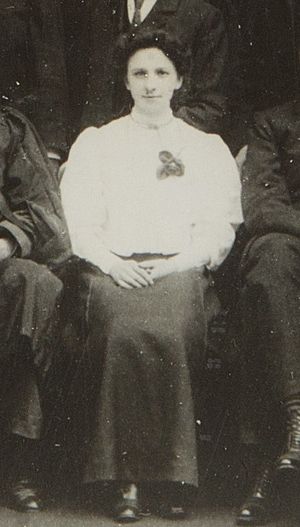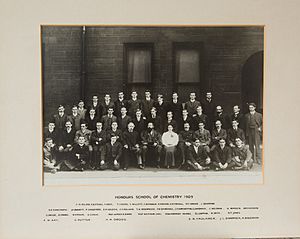Rona Robinson facts for kids
Rona Robinson (1884–1962) was an amazing British woman who achieved many firsts! She was the first woman in the United Kingdom to earn a top-level degree in chemistry. She was also one of the very first women to work as a chemist in factories. Besides her science work, Rona was a brave British suffragette. Suffragettes were women who fought for the right to vote. Rona was a paid member of the Women's Social and Political Union (WSPU), a group that worked hard for women's voting rights.
Contents
Rona's Early Life
Rona Robinson was born on June 26, 1884. She was the youngest child of Jessie and Fred Robinson. Her parents were from the Manchester area in England. Rona grew up in a working-class family, meaning her family earned money through jobs like her father's, who was a cotton goods traveler.
When Rona was young, her father passed away. To support her family, her mother, Jessie, took in lodgers (people who paid to rent rooms in their house). This helped them make ends meet.
School and Studies
Rona went to one of the Manchester Central Schools. When she was 15, she won a special science award worth £15 each year. This money helped her continue her studies for longer than most students at that time.
In 1902, Rona earned a scholarship to study at Owens College, Manchester. This college later became part of the Victoria University of Manchester. She was a brilliant student there. In her first year, she was among the top students in organic chemistry.
In 1905, Rona graduated with a first-class honors degree in chemistry. This was a huge achievement! She also won the LeBlanc medal and a Mercer scholarship. This made her the first woman in the United Kingdom to earn a top-level degree in chemistry. Rona continued her studies and earned her Master of Science (MSc) degree in 1907. She even published a science paper during this time.
Fighting for Women's Rights
After finishing university, Rona became a teacher. She worked with another woman named Dora Marsden. Rona and Dora both became very interested in women's suffrage, which was the movement to get women the right to vote.
They both left their teaching jobs to focus on helping the Women's Social and Political Union (WSPU). They became paid organizers for the group. Rona and her friend Mary Gawthorpe gave speeches in Manchester in 1908.
Protests and Arrests
Rona and Dora were once put in prison for a month. This happened after they tried to meet with the Prime Minister, H. H. Asquith, in 1909. They were arrested for causing trouble during their protest.
In October 1909, Rona, Dora, and Mary were arrested again. They wore their special university gowns and interrupted a speech at the Victoria University of Manchester. They wanted the university leader to speak out against the force-feeding of suffragettes in prison. Force-feeding was a harsh way to make women eat when they went on hunger strike. The police were very rough with the women that day. But the university leader was so moved by their protest that he decided not to press charges. This saved Rona from going to prison again.
Hunger Strikes
Rona was put in prison several times for her protests. She even went on hunger strike during her time in prison. This was a planned tactic by the WSPU. Women would refuse to eat or drink when they were in prison. This often led to them being released early because of their health.
Rona received a special Hunger Strike Medal from the WSPU. This silver medal had "HUNGER STRIKE" on one side and "RONA ROBINSON" on the other. It also had two bars that showed the dates of her two hunger strikes: "OCTOBER 15th 1909" and "AUGUST 20th 1909." Only about 100 of these medals were given out.
Rona's Views on Domestic Science
Rona was very open about her feminist ideas. She gave a talk about ending "Domestic Drudgery," which meant making household chores less of a burden for women.
In 1912, Rona received a scholarship to study Home Science and Economics. However, she soon quit the program. She believed the course was "worthless from an educational point of view." Rona thought that women needed to study "pure science" seriously. She believed that if women wanted science to help with household tasks, they either had to become serious scientists themselves or ask men who were scientists for help. She wrote a lot about her criticisms of domestic science, especially in magazines for women.
A Life in Chemistry
Rona Robinson is known as one of the first female research chemists. After graduating, she spent eight years researching dyes in a lab at her home.
In 1915, she joined a company called W.B. Sharpe as an analytical and research chemist. This meant she tested chemicals and worked on new discoveries. She also helped turn her chemical ideas into large-scale products. In 1916, she was promoted to Chief Chemist. She became a member of the Royal Institute of Chemistry in 1919.
In 1920, Rona became Chief Chemist at Clayton Aniline. While working there, she invented three new things that were given patents. Patents protect new inventions. She stayed at Clayton Aniline until she retired.
Later Life
Rona Robinson passed away on April 7, 1962, when she was 77 years old. After her death, money from her will was used to create the Rona Robinson scholarship. This scholarship helps female students who are studying chemistry at the University of Manchester today.



